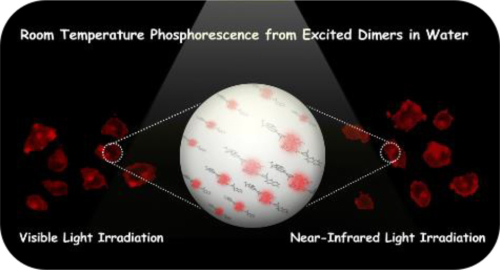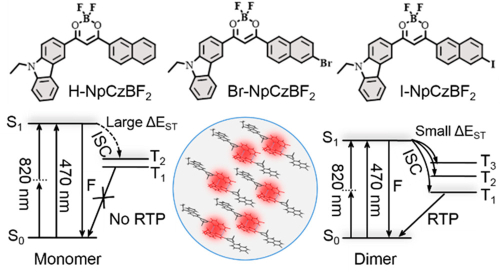
Scientists have developed a pure organic room temperature phosphorescence (RTP) that was excited by visible- and NIR-light.
The findings were published in JACS.
Most recently, a research team led by CHEN Yuzhe and WU Lizhu at Lab of Supramolecular Photochemistry, Technical Institute of Physics and Chemistry (TIPC) of the Chinese Academy of Science developed the organic RTP molecular systems which can be excited by the visible one-photon absorption and two-photon excitation in the near-infrared (NIR) region.
Previously, ultraviolet (UV) light can be adopted to obtain RTP. However, the high phototoxicity and low penetration depth of UV light as well as the inability of solids to penetrate cells restrict the real application of pure organic RTP in biological system.
In this work, Difluoroboron β-diketonate derivatives (BF2dbk) (H-NpCzBF2, Br-NpCzBF2, I-NpCzBF2) are assembled to form nanoparticle (HNPs, BrNPs, INPs) in water.
These NPs were found to demonstrate quite efficient RTP behaviors under visible-and NIR light irradiation both in aqueous solution and in HeLa cells.
Intriguingly, systematic spectroscopic studies, single-crystal X-ray diffraction and theoretical investigations, dimer excited states have been disclosed as a new emissive species responsible for organic RTP.
This study will open a new window for in-depth understanding of the nature of RTP induced by assembly and promote the broad application of organic RTP materials.

Fig1. Room Temperature Phosphorescence from Excited Dimers in Water. (Image by TIPC)

Fig2. Molecular Structures of Compounds H-NpCzBF2, Br-NpCzBF2, and I-NpCzBF2 and General Jablonski Diagram Illustrating the Production of Visible- and NIR-Light Triggered RTP from the Exquisite Dimer in NPs. (Image by TIPC)

86-10-68597521 (day)
86-10-68597289 (night)

86-10-68511095 (day)
86-10-68512458 (night)

cas_en@cas.cn

52 Sanlihe Rd., Xicheng District,
Beijing, China (100864)

